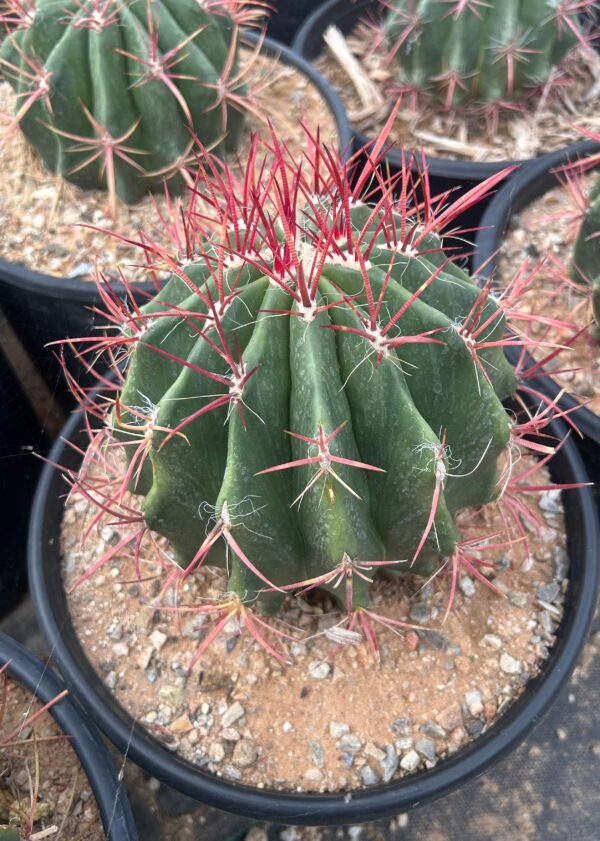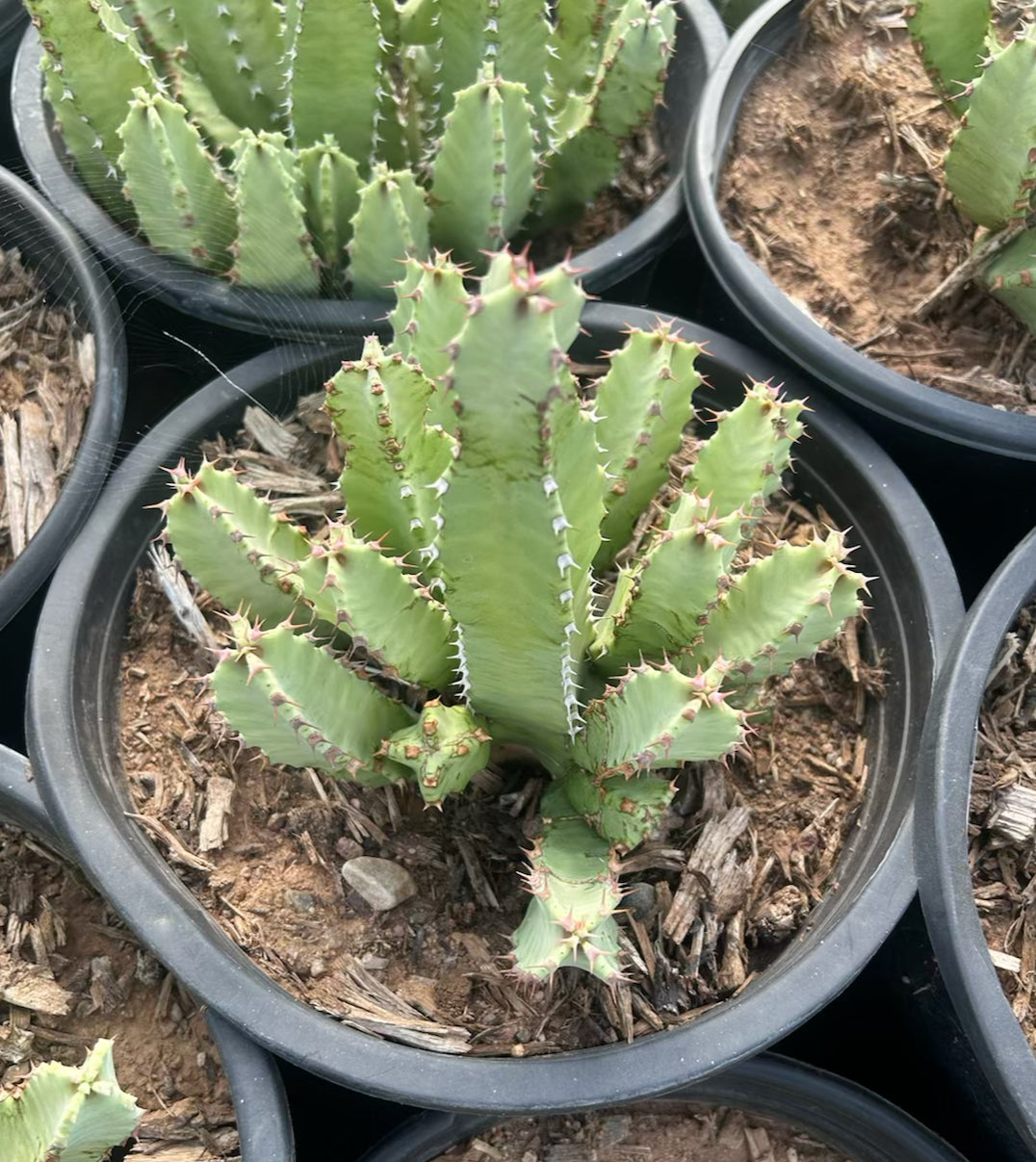New
Moroccan Mound Cactus – Euphorbia resinifera
Buy Moroccan Mound Cactus online (Euphorbia resinifera) is a spectacular, shrubby succulent native to the Atlas Mountains of Morocco. Unlike columnar cacti such as the San Pedro or Peyote, this species grows in dense clusters, forming wide mounds that can reach several feet across. Its unique structure, thick stems, and striking blue-green color make it a true statement plant for collectors, gardeners, and lovers of rare succulents. Known for both its ornamental beauty and its historic medicinal applications, the Moroccan Mound is considered one of the most iconic cactus-like Euphorbia species in the world.
Origin and Natural Habitat
The Moroccan Mound originates from the arid slopes and rocky landscapes of the Atlas Mountains, where it thrives in extremely dry, desert-like conditions. Adapted to harsh sunlight, minimal rainfall, and poor soil, Euphorbia resinifera has evolved to form large clumps that resemble a cactus fortress. Its dense mounds are not only visually striking but also serve as natural protection against grazing animals.
The plant gets its name directly from Morocco, where it grows wild in expansive colonies that cover the dry mountain foothills. Unlike some other desert plants, this species has been historically cultivated and even revered for centuries, not just for its beauty but also for the potent resin it produces, which has been used in traditional medicine. Buy Moroccan Mound Cactus Online
Appearance and Growth
The Moroccan Mound cactus forms dense clumps of upright, four-sided stems that grow between 1–2 feet tall, eventually expanding outward to form wide, cushion-like mounds. Each stem is thick, fleshy, and covered with short spines along the ridges. The coloration ranges from silvery-green to blue-green, which glows beautifully under bright sunlight.
Mature plants can spread extensively, creating dramatic landscape features when planted outdoors in warm climates. In pots, it remains manageable but still develops its characteristic clustered mound structure, making it a highly desirable ornamental succulent for collectors and landscapers alike.
Resin and Traditional Uses
Buy Moroccan Mound Cactus Online. One of the most fascinating aspects of the Moroccan Mound cactus is its natural resin, which has been harvested for centuries. Known as Euphorbium resin, this substance was traditionally used in North Africa and parts of Europe for medicinal purposes, particularly as a powerful purgative and in topical applications for pain relief.
While modern medical science no longer recommends its use due to its extreme potency and irritant qualities, the resin gives this plant a unique historical and cultural importance. The Moroccan Mound Euphorbia stands out not only as a decorative cactus-like succulent but also as a plant tied to ancient herbal traditions.
Care and Cultivation
Growing Moroccan Mound cactus is relatively easy, provided it is given the correct conditions. Like most desert succulents, it thrives in full sunlight, well-draining soil, and minimal water. It is highly drought-tolerant and can survive long dry periods thanks to its thick, water-storing stems.
Soil Requirements:
-
Use a gritty, sandy cactus or succulent mix.
-
Ensure excellent drainage to prevent root rot.
-
Avoid compact or clay soils.
Watering Needs:
-
During spring and summer, water sparingly every 2–3 weeks, only when the soil has fully dried.
-
In autumn and winter, reduce watering drastically, as the plant enters dormancy.
-
Overwatering is the most common mistake; the Moroccan Mound prefers to stay dry rather than wet.
Light and Temperature:
-
Requires bright sunlight and thrives outdoors in desert-like conditions.
-
Can tolerate temperatures down to around 25–30°F (−3 to −1°C) if kept dry, but prefers warmer climates.
-
Indoors, place near a south-facing window for maximum light exposure.
Landscaping and Decorative Appeal
Buy Moroccan Mound Cactus Online. Because of its bold, architectural form, the Moroccan Mound cactus is often used in desert-themed gardens, rock gardens, and xeriscaping projects. When planted in groups, it creates dramatic mounding structures that look like living sculptures. Its sharp, angular lines contrast beautifully with smooth stones, gravel, and other succulents like Agave, Aloe, and San Pedro cactus.
Collectors also prize it as a container plant, where it can be grown on patios, greenhouses, or sunrooms. With minimal care needs and impressive structure, it is one of the most versatile ornamental Euphorbias available.
Safety Considerations
Like many Euphorbias, the Moroccan Mound cactus contains a milky white latex sap that is highly toxic and irritating to the skin and eyes. Extreme caution should be used when pruning, repotting, or propagating this plant. Gloves and protective eyewear are strongly recommended.
While it is safe as a decorative plant when handled carefully, it should always be kept away from children and pets, as ingestion can cause severe health reactions. Buy Moroccan Mound Cactus Online
Why Collectors Love Moroccan Mound
-
Rare cactus-like Euphorbia with unique clustered growth.
-
Striking ornamental plant for both indoor and outdoor use.
-
Historic significance due to its resin and traditional medicinal role.
-
Drought-tolerant and low-maintenance once established.
-
Long-living and capable of forming massive, impressive mounds.
Order Moroccan Mound Cactus Online
At Cactus Smart Shop, we offer authentic Moroccan Mound (Euphorbia resinifera) cactus plants for collectors and enthusiasts. Each specimen is carefully cultivated under ideal conditions to ensure healthy root systems, strong growth, and vibrant color.
Whether you’re seeking a statement plant for your desert garden, a rare succulent to add to your collection, or an ornamental cactus-like Euphorbia for your patio, the Moroccan Mound is a perfect choice.
Bring home this extraordinary plant and enjoy the rugged beauty of Morocco’s desert landscapes in your own garden.



